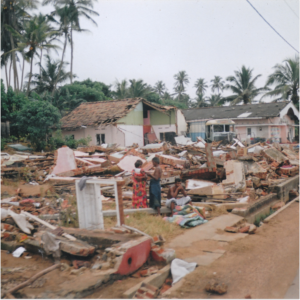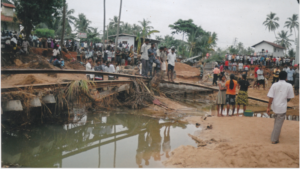15-year-old Anastasia Kulikova revisits the tragedy of the Boxing Day tsunami on its 20th anniversary
December 26, 2024
Sri Lanka survivors remember the Indian Ocean tsunami, 20 years on
On 26 December 2004, the Indian Ocean tsunami struck, one of the deadliest natural disasters in recent history. The tsunami affected 18 countries around the Indian Ocean, including India, Indonesia, Malaysia, the Maldives, Sri Lanka and Thailand, claiming the lives of at least 225,000 people and causing immense environmental devastation.
The cause of the tsunami was an undersea earthquake with a magnitude of 9.1, which occurred off the coast of Sumatra. In Sri Lanka, two waves struck the coast. The first arrived between 8.30am and 8.45am, while the second – the larger wave at nearly nine metres high – hit between 8.50am and 9.15am. The east and south coasts were worst affected, with more than 30,000 deaths and thousands injured.
Harbingers’ Weekly Brief
Harbingers’ Magazine spoke to some of the survivors in Galle, who are still feeling the impact of the experience, 20 years later.
“Run, brother, run!” is the phrase recalled by Amila Anurudha Bandaranayake, 34, now an officer in charge of the National Maritime Museum in Galle Fort. At the time of the tsunami, Amila was just 14 years old. He remembered being confused and asking those fleeing what was happening before being urged to run for his life. That advice saved him from drowning.
“I noticed a wave slowly rising,” said Damika Prasanna, 55, a cobbler who had been in the trade for decades. He was seated near a traffic light in Galle, mending shoes, when he saw the water rise and the terrified expressions of people around him.
Realising the danger, Damika ran into a building to escape. Though he survived, he lost his tools, a major setback for his livelihood. The government gave him 200,000 Sri Lankan rupees (now about $690) to rebuild his home, but he felt it was insufficient to cover his losses.
“I thought, ‘I’m going to survive this wave’, so I ran,” remembers Ruwan Thelikada Paliya Guruge, 45, who was a chef at a newly opened beachside restaurant when the waves hit. The first wave brought water on to the road, which Ruwan and his six co-workers thought was it – they didn’t realise there would be another wave.
When he was retrieving musical instruments from the beach, Ruwan saw the second wave – an enormous wall of water – coming towards him. He dropped everything and ran. The wave pushed him over, and he found himself swimming. He walked for nearly a kilometre through thigh-high water to safety. Along the way, he helped a girl stranded atop a palm tree. Once safe, he returned to assist others.
Chaminda Peramunage, 48, a businessman from Galle who runs his own restaurant. He recalled witnessing cobbler’s tools, shoes and other objects floating in the streets of the town as the canal overflowed. Amid the chaos, he heard bone-chilling screams that alerted him to the danger. Customers in his restaurant warned him that “the tide” was coming, prompting him to take action.
“I climbed on to tall buildings and statues with a few others to save people,” he said. Despite his efforts to help others, Chaminda lost his sister to the waves.
He added that the government never assisted him in rebuilding his business, leaving him to rely on family support. Although he had heard of early warning systems, Chaminda said he had never seen one in operation.
The Boxing Day tsunami left behind countless stories of loss and survival. Accounts like those of Damika, Amila, Ruwan and Chaminda reveal the scale of the disaster and the resilience of its survivors. Many noted the lack of government support in rebuilding their lives after the tsunami, and highlighted the absence of an adequate early warning system.
In fact, the lack of preparedness and knowledge was one of the biggest killers. Many people, despite having lived next to the sea their entire life, did not know what the warning signs of a tsunami were. They didn’t realise that the receding waterline was a sign of danger – the ‘trough’ (low point) of the tsunami that would soon be followed by the ‘crest’ (high point).
Many survivors recall how residents ran towards the receding waterline, believing that more land was emerging and eager to claim it. However, as they moved further into the exposed seabed, they were caught off guard and overtaken by the massive wave that followed.
Two decades later, while some schools in Sri Lanka now teach disaster preparedness, survivors express concern about the current state of readiness. Early warning systems, though discussed after the tsunami, have not been widely utilised or maintained. Many Galle residents also told Harbingers’ Magazine that no tsunami drills had been conducted in the area in a long time.
These experiences underscore the need for robust disaster preparedness to ensure better outcomes in future emergencies. By learning from these stories, communities can build resilience and work towards a safer future.
Interviews for this article were conducted through fieldwork as part of the Sri Lankan Newsroom. With special thanks to 14-year-old Dinaya Jayalath who did most of the interviews and translated them from Sinhala into English.
Written by:

Writer
Sydney, Australia
Born in 2009 in Saint-Petersburg, the cultural capital of Russia, Anastasia spent a year as a student in Sri Lanka. Then, since December 2023, she has lived in Sydney, Australia. She is part of Harbingers’ Magazine’s Sri Lankan Newsroom.
In her free time, Anastasia enjoys reading and playing musical instruments. She likes to participate in musicals and is fond of travelling.
Anastasia can fluently speak English and Russian while trying to learn Spanish.
🌍 Join the World's Youngest Newsroom—Create a Free Account
Sign up to save your favourite articles, get personalised recommendations, and stay informed about stories that Gen Z worldwide actually care about. Plus, subscribe to our newsletter for the latest stories delivered straight to your inbox. 📲
© 2025 The Oxford School for the Future of Journalism




